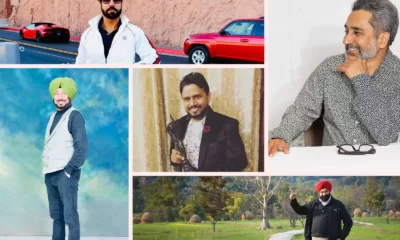Daily News
Mohali: The Fastest Growing City in Punjab
Introduction
Mohali, an integral part of the Chandigarh Tricity area, along with Panchkula in Haryana, has emerged as a symbol of rapid urbanization and growth since the 1980s. This bustli

Mohali, an integral part of the Chandigarh Tricity, has rapidly transformed since the 1980s into a symbol of urban growth and modernization. Recognized as the fastest growing city in Punjab, it benefits from its strategic location next to Chandigarh, India’s first planned city designed by Le Corbusier. Named after the revered Sikh Guru Mohan Singh, Mohali blends cultural heritage with the momentum of industrial and educational progress.
From a modest township, Mohali has evolved into a bustling urban hub. Economic liberalization in the 1990s fueled its transformation, attracting industries, IT parks, and educational institutions. This rapid growth strengthened its identity as a prime residential and commercial center, supported by malls, housing complexes, and recreational spaces.
Education has played a decisive role in shaping Mohali’s character. Punjab’s literacy rate of 76.68% surpasses the national average, and the city reflects this achievement through its renowned institutions like Punjab Engineering College and the Indian School of Business. These institutes not only boost Mohali’s academic prestige but also attract students nationwide, enriching its social and economic landscape.
Infrastructure development has further enhanced the city’s appeal. With strong road and rail links, along with the Chandigarh Airport extending into Mohali, connectivity is seamless across Punjab and Northern India. The government’s initiatives in water supply, sanitation, and waste management continue to raise living standards, while new housing projects and industrial zones sustain population and economic growth.
Technology has cemented Mohali’s place as a rising IT hub. The Mohali IT City provides space for startups and established firms, creating jobs and fostering innovation. Smart city projects, including intelligent traffic systems and public Wi-Fi, are steadily redefining urban life with efficient and sustainable solutions.
Culturally, Mohali thrives on diversity. Its residents include Punjabis, Haryanvis, and people from across India, who collectively celebrate festivals, art exhibitions, and music events. Heritage sites, gurudwaras, and monuments preserve its historic roots, adding depth to its modern identity.
Nevertheless, challenges remain. Rapid urbanization brings traffic congestion, pollution, and the urgent need for sustainable infrastructure. Addressing these issues will be critical to sustaining Mohali’s rise while ensuring livability for future generations.
In conclusion, Mohali represents Punjab’s vision for modern urban development. With strong foundations in education, industry, and culture, it continues to expand its influence within the region. Widely recognized as the fastest growing city in Punjab, Mohali exemplifies progress, resilience, and aspiration, making it one of the state’s most promising metropolitan areas.
Daily News
Tere Ishq Mein Review: Dhanush and Kriti Sanon’s Intense Romance Wins Hearts

Tere Ishq Mein review from early audience reactions suggests the film has struck a chord with viewers. Dhanush and Kriti Sanon’s intense romantic drama hit theatres on November 28. Fans rushed to catch the first day, first show, and social media quickly filled with positive responses.
The film marks Dhanush’s third collaboration with director Aanand L Rai. Previously, they worked together on Raanjhanaa in 2013 and Atrangi Re in 2021. This time, however, Dhanush plays a completely different character. He portrays a reckless and toxic lover, starkly opposite to his earlier roles.
Before release, advance bookings showed strong numbers. The film sold tickets worth Rs 2.95 crore across India. Additionally, it secured over 1.3 lakh tickets for the opening day. In Hindi alone, advance sales reached Rs 2.81 crore with 10,774 shows. Meanwhile, the Tamil version collected Rs 1.38 crore with 595 shows.
#TereIshkMeinReview ~ INTENSE & HEART WRENCHING!
Ratings – ⭐️⭐️⭐️⭐️#TereIshkMein is a BONAFIDE BLOCKBUSTER as Aanand L Rai goes WILD with raw emotions, superb storytelling, and brilliant performances by the star cast🔥
The 1st HALF is TIGHT and sets up the story with an… pic.twitter.com/7L5wraYZJN
— CineHub (@Its_CineHub) November 28, 2025
Trade expert Taran Adarsh expressed optimism about the film’s performance. He estimated opening day collections might reach Rs 12 crore or more. Furthermore, he praised the teaser and trailer, calling them quite promising.
Notably, the film follows a similar theme to Ek Deewane Ki Deewaniyat, which earned Rs 112 crore in October. Both films explore toxic love stories. Consequently, trade experts believe this theme might work favorably again.
The trailer created significant buzz on social media platforms. It opens with a haldi ceremony where Kriti Sanon appears as a bride-to-be. Suddenly, a bruised Dhanush walks in, changing the festive atmosphere completely. He delivers a powerful dialogue about cleansing past sins before starting a new life.
Subsequently, the trailer showcases an intense and destructive love story. One character finds solace in alcohol, while the other turns to violence. This raw portrayal resonated strongly with audiences.
Dhanush’s performance emerges as the film’s biggest highlight. Viewers praise his raw and powerful acting throughout. Many describe him as being in “full heroic mode.” Moreover, fans note how his expressions alone convey deep emotional turmoil effectively.
Kriti Sanon also delivers a compelling performance alongside Dhanush. Their chemistry creates the emotional core of this romantic drama. Together, they bring authenticity to this complex love story.
The film features music by legendary composer A.R. Rahman. Himanshu Sharma and Neeraj Yadav wrote the screenplay. Additionally, Prakash Raj plays a pivotal supporting role.
Interestingly, Tere Ishq Mein outperformed several big releases in bookings. It sold more tickets than Aamir Khan’s Sitaare Zameen Par and Akshay Kumar’s Jolly LLB 3. This achievement indicates strong audience interest in romantic dramas.
Bhushan Kumar backed the project, ensuring quality production values. The film was released in three languages – Hindi, Tamil, and Telugu. This multi-language strategy helps reach wider audiences across India.
In conclusion, Tere Ishq Mein review from early viewers suggests a potential blockbuster. The intense performances, gripping storyline, and strong bookings point toward a successful box office run ahead.
Daily News
Gold Rates Today: Prices Jump Near Two-Week Highs on Fed Rate Cut Hopes

Gold rates today showed strong gains in the domestic market on Friday morning. MCX gold February futures climbed to Rs 1,28,313 per 10 grams, marking a rise of Rs 646 or 0.51%. Meanwhile, silver prices also gained momentum, trading 1% higher at Rs 1,63,849 per kg.
Several factors are driving this upward trend. First, the wedding season has created a healthy spot demand across India. Additionally, expectations of a December rate cut by the US Federal Reserve are boosting investor confidence. Furthermore, the dollar’s weakness in global markets is making gold more attractive to buyers.
According to FXStreet data, gold prices in India reached Rs 12,028.43 per gram on Friday, up from Rs 11,954.88 the previous day. Similarly, the price per tola increased to Rs 1,40,297.20 from Rs 1,39,439.40.
⤴️ #Gold catches fresh bids amid rising bets for another Fed rate cut in December.
💪 The XAU/USD #bulls seem rather unhindered by a modest USD uptick and the risk-on mood.
Trade Gold? Check this out 🖱️https://t.co/43zBYFVppF pic.twitter.com/YdLtavcGWt
— FXStreet News (@FXStreetNews) November 28, 2025
Market experts suggest that gold remains a stable investment option during uncertain times. The yellow metal continues to be viewed as a safe asset, particularly for long-term investors. However, traders should note that prices may be volatile due to ongoing global events and economic data releases.
For today’s trading session, gold has key support levels at Rs 1,25,050 and Rs 1,24,380. On the other hand, resistance levels are positioned at Rs 1,26,550 and Rs 1,27,100. Silver shows support at Rs 1,61,250 and resistance at Rs 1,63,410.
#Gold prices steady at Rs 1,26,180
Check rates in Delhi, Mumbai, Kolkata and other cities
Read more: https://t.co/wjZfcWcKgU pic.twitter.com/rRqRJ79FWH
— NDTV Profit (@NDTVProfitIndia) November 28, 2025
Industry experts believe the current market conditions favor buyers. The stability in foreign exchange markets, combined with seasonal demand, creates a favorable environment for gold investment. Moreover, the ongoing wedding season across India typically brings increased purchases of gold jewelry and coins.
Despite the positive trend, experts advise caution. The market may see fluctuations based on European economic data and changes in the dollar index. Therefore, investors should monitor these indicators closely before making significant purchases.
Looking ahead, analysts remain optimistic about gold’s prospects. The precious metal should continue to attract investors as a hedge against inflation and a store of value. Consequently, many financial advisors recommend including gold in a diversified investment portfolio.
In conclusion, gold rates today reflect strong market fundamentals and positive investor sentiment. Whether you’re buying for investment purposes or for the festive season, the current levels offer opportunities for both short-term traders and long-term holders.
Daily News
Sameer Wankhede Defamation Case: Red Chillies Defends Netflix Series in Delhi High Court

IRS officer Sameer Wankhede filed a defamation suit against Red Chillies Entertainment and Netflix over the web series “The Bas***ds of Bollywood,” directed by Aryan Khan. On Wednesday, Shah Rukh Khan’s production house opposed Wankhede’s plea seeking an interim injunction on the show in the Delhi High Court. Consequently, senior advocate Neeraj Kishan Kaul argued that the series does not depict the Cordelia cruise incident.
Red Chillies Entertainment defended itself before Justice Purushaindra Kumar Kaurav, stating that satire and fiction can coexist. Moreover, Kaul emphasized that the show draws inspiration from overzealous officers but does not reference Wankhede or the cruise case specifically. “Can satire and fiction co-exist? There is no law that it cannot co-exist,” Kaul stated on behalf of his client.
The production house’s counsel added that the series explores approximately 20 different issues affecting Bollywood. Furthermore, Kaul stressed that Red Chillies did not create a documentary about the Cordelia cruise incident. “I am inspired by overzealous officers. That is far from saying that this is the Cordelia cruise story,” he explained to the court.
Additionally, Red Chillies raised jurisdictional concerns about the case. Kaul argued that Wankhede resides in Mumbai, and Red Chillies’ registered office is also located there. Therefore, the suit should have been filed in the Bombay High Court instead of Delhi. “Clearly, the jurisdiction is Bombay and not Delhi. This is clearly a case where you have come court shopping,” Kaul asserted.
The controversy stems from events in October 2021 when Aryan Khan came into the spotlight. The Narcotics Control Bureau raided a rave party on the Goa-bound Cordelia Empress cruise ship off the Mumbai coast. Subsequently, the NCB team, led by then-Zonal officer Sameer Wankhede, arrested Aryan in connection with a drugs case.
Aryan spent more than three weeks in jail following his arrest. However, he later received a clean chit in the drugs case. This high-profile incident attracted massive media attention and public scrutiny. Meanwhile, various investigations into Wankhede’s conduct also emerged during this period.
Kaul pointed out that Wankhede frequently gives interviews to the media. Moreover, the lawyer noted that Wankhede “talked merrily” about issues after the Netflix series launched. Kaul referenced numerous news articles published over the past two years carrying details about extortion allegations against Wankhede. Additionally, he mentioned CBI and ED FIRs registered against the officer.
“The reason I am showing these is that these are instances of 2023 that have been reported. They are in the public domain,” Kaul explained. He stressed that information and allegations against Wankhede existed on the internet even before the series premiered. Furthermore, Kaul noted that Wankhede gave interviews after the show’s launch, stating that “it is all humour to him.”
The Bombay High Court has only directed the authorities not to take coercive action against Wankhede in the CBI and ED cases. Nevertheless, this means that investigations remain ongoing. Kaul argued that Wankhede cannot pick a one-minute scene out of context from a seven-part show to claim defamation.
Red Chillies’ counsel emphasized that the show is neither a biopic nor a documentary. Instead, it represents creative fiction inspired by real-time persons and events. “Even if I portray you unjustly, it is still not the case. Every scene in this show is exaggerated,” Kaul argued. He added that public officials should accept criticism when creative works highlight issues in their field.
Wankhede filed his defamation suit in September, seeking Rs. 2 crores in damages. Notably, he stated he would donate any awarded amount to the Tata Memorial Cancer Hospital for cancer patient treatment. The suit names Red Chillies Entertainment, Netflix, X Corp (formerly Twitter), Google LLC, Meta Platforms, RPG Lifestyle Media Private Limited, and John Doe as defendants.
In his plea, Wankhede alleged that one particular scene in the show mocks him. Moreover, he claimed the series contains “false, malicious, and defamatory content aimed at damaging his reputation.” Additionally, Wankhede contended that a character makes an obscene gesture by showing a middle finger after reciting “Satyamev Jayate.”
Wankhede’s suit argues this act violates the Prevention of Insults to National Honour Act, 1971. Furthermore, he claims the content contravenes various provisions of the Information Technology Act and the Bharatiya Nyaya Sanhita. The suit also states that the makers “deliberately conceptualised and executed” the series to malign his reputation, especially as the case involving him and Aryan Khan remains sub-judice.
The Delhi High Court scheduled Thursday to hear arguments on behalf of Netflix. Meanwhile, Red Chillies Entertainment maintains that it is fully entitled to depict issues affecting Bollywood and portray overzealous officers. The case continues as both sides present their arguments regarding jurisdiction, defamation claims, and creative freedom in the ongoing legal battle involving Sameer Wankhede and Shah Rukh Khan’s production company.
-

 Entertainment2 years ago
Entertainment2 years agoTop 15 Punjabi Models – Male and Female List
-

 City Guide3 years ago
City Guide3 years ago3B2 Mohali Market Shops: Discover 44 Hidden Gems
-

 Entertainment2 years ago
Entertainment2 years agoTop 11 Punjabi Comedians of All Time
-

 Jobs4 years ago
Jobs4 years agoTop 20 IT Companies in Mohali
-

 Food4 years ago
Food4 years ago11 Best Restaurants in Mohali You Must Visit
-

 Property2 years ago
Property2 years agoWho Lives In Homeland Mohali: Punjabi Celebrities, Business People…
-

 Food3 years ago
Food3 years agoTop 15 Cafes in Mohali you must visit
-

 Education2 years ago
Education2 years ago10 Famous Punjabi Writers With A Great Impact On The Literary World
